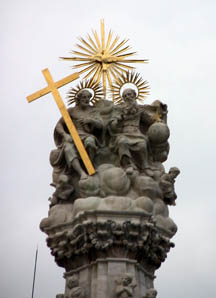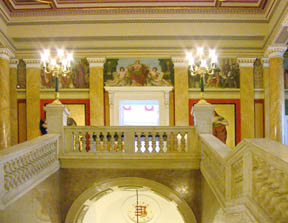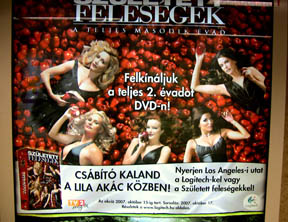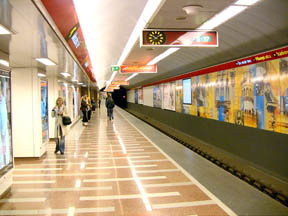We leave Norfolk at 1600 hours and arrive in Amsterdam at 0730 Sunday morning
local time. We spend the day walking along the canals of Amsterdam and visiting
museums, then have dinner on board our river cruise ship Amadagio. After
dinner, we leave the ship with newly made friends from Australia and Indiana and
visit the Red Light district of Amsterdam looking at the window displays under
the night lights.
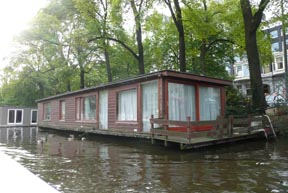 We have a good night sleep and then have a sightseeing bus and canal boat
tour of the city center and historical district. Amsterdam has 750,000 residents
and 600,000 bicycles which you can buy used at the flea market for 35 euros. You
then buy a 100 Euro lock, park the bicycle at work or school where it can get
stolen. You then go back to the flea market and buy the same bicycle back for
another 35 Euro -- the Dutch way of recycling.
We have a good night sleep and then have a sightseeing bus and canal boat
tour of the city center and historical district. Amsterdam has 750,000 residents
and 600,000 bicycles which you can buy used at the flea market for 35 euros. You
then buy a 100 Euro lock, park the bicycle at work or school where it can get
stolen. You then go back to the flea market and buy the same bicycle back for
another 35 Euro -- the Dutch way of recycling.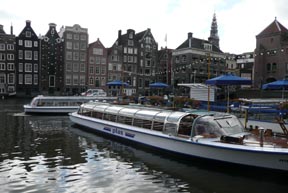
As we motor through the city we observe that the cyclists have the right of
way, they don't stop for pedestrians, red lights, or traffic. We see young
mothers drive three wheeled tricycles with a 3' x 3' box in front in which they
carry babies and preschool children. Many women work 4 days a week and on the
fifth day they stay home and take care of preschool children of 4 other moms on
a rotating basis, their cost effective way of day care.
There are six main canals that ring the old city of Amsterdam along with the
Amstel River. There are 600 bridges over the canals, and locks between the
canals and the river, which are opened 4-5 times a week to flush out the canals.
About once every two years, the canals are draine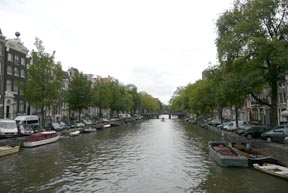 d one at a time to clean out
the bicycles, Frigidaires etc. which have been dropped in or lost. There are
about 2500 licensed houseboats docked along the canals, and these houseboats are
connected to the city water, power, and sewer system. When you can find one, the
houseboats cost about 200,000 euros, and the waiting time for dock space is up
to 10 years.
d one at a time to clean out
the bicycles, Frigidaires etc. which have been dropped in or lost. There are
about 2500 licensed houseboats docked along the canals, and these houseboats are
connected to the city water, power, and sewer system. When you can find one, the
houseboats cost about 200,000 euros, and the waiting time for dock space is up
to 10 years.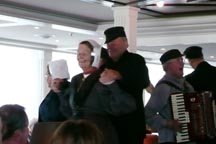
Leaving Amsterdam at noon on Sunday, we enter the Amstel-Rhine River canal
and sail to the Rhine River through a series of locks. We enter the Rhine and
sail south towards the German border and will pass Dusseldorf about 0400,
arriving at Cologne in the morning. Evening entertainment the first night was a
local Dutch folk dancing group with two accordions playing music, and on our
second night a very irreverent history of the Rhine Danube history which kept
all of us laughing as we saw pictures of Empress Maria Theresa of Austria as a
17 year old lass and after she had 17 children. By the way, she was the one who
invited German people to emigrate to Romania and Serbia, which is why Judy's
German ancestors were actually from Romania.
That is all for tonight, we wake up in the morning in Cologne, Germany.
Rhine-Danube Adventure Day 4 - Cologne to Koblenz
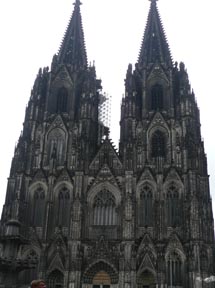
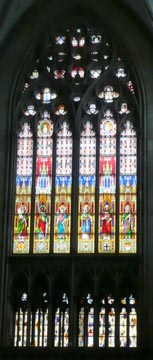
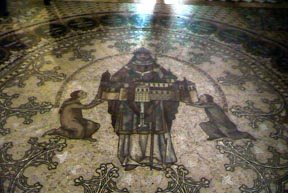 The word "Cologne" comes from the Latin "Colone" meaning colony. It was
founded by the Roman empress Agropina who assumed that title after she poisoned
her husband. Here mushrooms are still eaten freely to this day, but you must pay
before you eat.
The word "Cologne" comes from the Latin "Colone" meaning colony. It was
founded by the Roman empress Agropina who assumed that title after she poisoned
her husband. Here mushrooms are still eaten freely to this day, but you must pay
before you eat.
The Romans had their colonial center here for five centuries, occupying the
west side of the Rhine while the Germanic tribes occupied the east bank. As
these tribes did not know how to build with stone, the stone foundations are all
from the Roman times, many were excavated after WW-II during reconstruction.
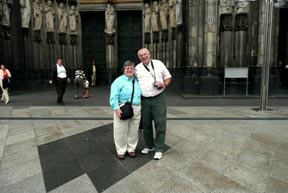 Cologne people are more Italian than German due to the more than 500 years of
Roman influence. They appreciated JFK visiting here as well as Berlin, where he
declared "Ich bien ein Berliner." When President Clinton visited Cologne during
his presidency, he stood up in front of the admiring crowd and declared "Ich
bien ein Kolshe" which means "I am a beer!"
Cologne people are more Italian than German due to the more than 500 years of
Roman influence. They appreciated JFK visiting here as well as Berlin, where he
declared "Ich bien ein Berliner." When President Clinton visited Cologne during
his presidency, he stood up in front of the admiring crowd and declared "Ich
bien ein Kolshe" which means "I am a beer!"
We walked to the cathedral in Cologne, the largest Gothic cathedral in the
world. Build between 1150 and 1850, it could not be completed until technology
caught up with vision. It was the tallest building in Europe until the Eifel
Tower was constructed in 1895. It is where the relics of the three wise men are
interred, hence the official name of the church is the Cathedral of Burial of
the Three Wise Men.
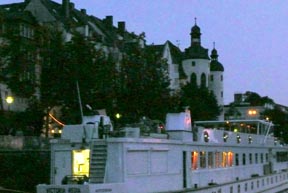
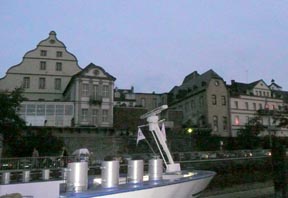 As was Westminster Cathedral in London, this cathedral was not bombed by the
Allies during WW-II, although the stained glass windows were removed before the
war and stored safely underground until that conflict was over.
As was Westminster Cathedral in London, this cathedral was not bombed by the
Allies during WW-II, although the stained glass windows were removed before the
war and stored safely underground until that conflict was over.
Leaving Cologne at 1300 hours, we entered the Rhine Gorge after passing Bonn,
the formal capitol. Continuing south, we passed the ruins of the Remagen Bridge,
made famous during the second war as "The Bridge too Far."
After dinner we made port at Koblenz, at the confluence of the Mosel and
Rhine Rivers, and walked around the old town at night, before being treated to a
classical trio for an hour before retiring. Tomorrow we leave Koblenz at 0600
hours as we spend Wednesday passing the castles on either side of
the Rhine.
Rhine-Danube Adventure Day 5 - Castles on the Rhine
We began our day early with a scenic cruise through the Rhine Valley, passing
by over 20 castles, many restored and some not, and we passed by the Lorelei
Rock, where the lovely siren lured mariners to dash themselves on the rocks
under her spell.
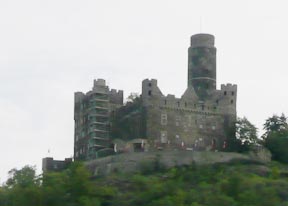
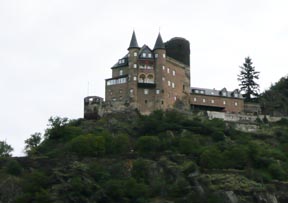
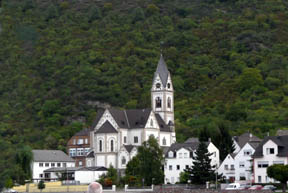
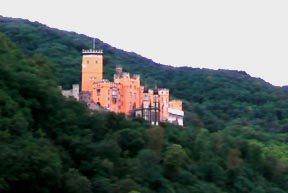
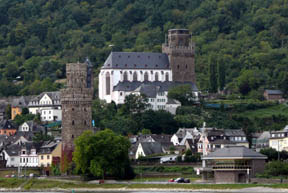 At about 1400 hours, we docked at Mainz, the crossroads of the Rhine, where
the Main river joins the Rhine. The Rhine is not the longest but it is the
busiest river in the world, with an average of over 300 commercial ships a day
passing by Mainz, on their way between Basel Switzerland and Amsterdam and the
sea. Fifty miles upstream of Mainz is the town of Worms, where Martin Luther
published his famous manifesto and initiated the Reformation. Eight miles from
Mainz is the US Air Force base and military hospital at Wiesbaden, and Frankfurt
International Airport is only 10 miles away, so Mainz is where pilots and flight
attendants stay between flights.
At about 1400 hours, we docked at Mainz, the crossroads of the Rhine, where
the Main river joins the Rhine. The Rhine is not the longest but it is the
busiest river in the world, with an average of over 300 commercial ships a day
passing by Mainz, on their way between Basel Switzerland and Amsterdam and the
sea. Fifty miles upstream of Mainz is the town of Worms, where Martin Luther
published his famous manifesto and initiated the Reformation. Eight miles from
Mainz is the US Air Force base and military hospital at Wiesbaden, and Frankfurt
International Airport is only 10 miles away, so Mainz is where pilots and flight
attendants stay between flights.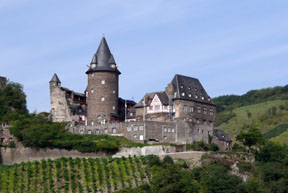
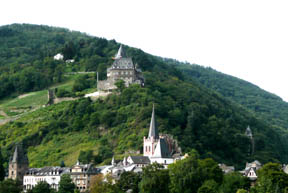
Going ashore, we visited the Gutenberg Museum, and BJ participated in the
printing of a page from the bible, using the same design of equipment as
Gutenberg used. We learned that Gutenberg had three separate inventions that
made modern printing possible. First, movable type which was cast from an alloy
of tin-bismuth-antimony-lead, and had a low melting point of 300 degrees C and
was also soft enough that the typeface would not tear the printed page.
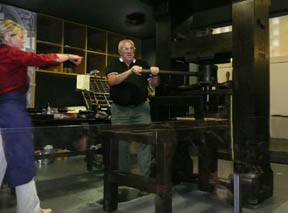
The
second invention was the setting board for movable type, and the third was the
printing ink made from soot and oil which transferred the image to the printed
page.
Gutenberg found that the best medium for printed pages was parchment made
from the skins of unborn animals, so required the killing of unborn calves to
make the parchment. The reason for using this skin was that it has no pores, as
pores are formed only after birth. Poreless parchment could be printed on both
sides without the ink bleeding through. The first 50 copies of the Gutenberg
Bible, including the copy in the US Library of Congress, were printed on
parchment made from unborn calf skin. After this, Gutenberg used paper made from
linen rags, and this made his books less costly and affordable to more people.
The Gutenberg bibles were printed using black ink on white paper, all
illustrations and colored type was added by illustrators by hand onto the
printed page. For this reason, no two copies are identical. Of 187 total copies
printed, only 46 survive, and are worth up to 50 million euros each.
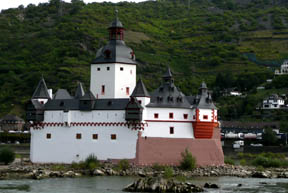
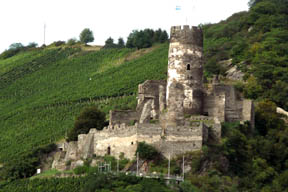
We visited the Romanesque St. Martin's Cathedral of Mainz, which was
destroyed by bombing in WW-II but has been totally restored.
Passing through the
old city with its half-wood construction, (we call it Tudor style) we toured St.
Stephens church with its nine stained glass windows by the Jewish artist Marc
Chagall which he created from 1978 as a sign of Jewish-Christian solidarity. These windows are beautiful and BJ tried to capture them with his camera.
Returning to our ship, we left the Rhine and turned into the Main River and
passed by Frankfurt Am Main around 2200 hours.
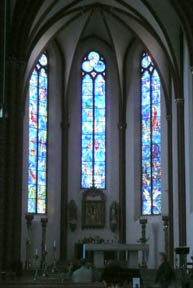
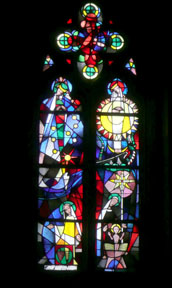
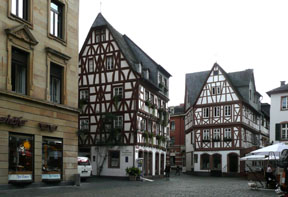 At our evening presentation by
our cruise director, he read suggestions made by our fellow passengers as to how
to make our cruise more pleasurable. The best suggestion was to serve the
gentlemen hot chocolate and Viagra before bedtime, the hot chocolate to aid in
sleeping, and the Viagra to help them from falling out of the bed.
At our evening presentation by
our cruise director, he read suggestions made by our fellow passengers as to how
to make our cruise more pleasurable. The best suggestion was to serve the
gentlemen hot chocolate and Viagra before bedtime, the hot chocolate to aid in
sleeping, and the Viagra to help them from falling out of the bed.
We will be continuing up the Main River Thursday.
Rhine-Danube Adventure days 6-7 - Up the Main River
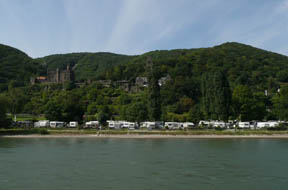
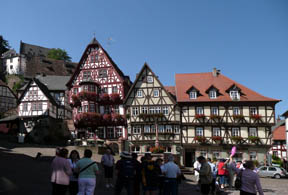 On Thursday and Friday we cruised up the Main River, smaller and cozier than
the Rhine, and with much less waterway traffic as well. Along its banks lie
quaint villages and picturesque homes, as well as riverside trailer parks filled
with caravans (camper trailers in the USA) where mostly retired couples sit on
lawn chairs and watch the river traffic.
On Thursday and Friday we cruised up the Main River, smaller and cozier than
the Rhine, and with much less waterway traffic as well. Along its banks lie
quaint villages and picturesque homes, as well as riverside trailer parks filled
with caravans (camper trailers in the USA) where mostly retired couples sit on
lawn chairs and watch the river traffic.
On our first day on the Main River, we stopped at two of the regions most
picturesque villages, Miltenberg and Wertheim. In Miltenberg, the town stood
still after the 30 Years War between the Catholics and Protestants in the 1600s,
and still today the town is made up of half timbered houses and town wells and
old churches.
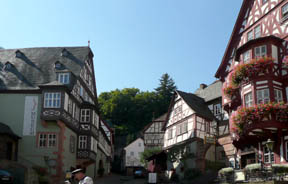
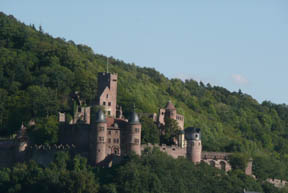 Continuing upstream on the Main, we stopped at Wertheim, which is the glass
blowing capitol of Germany. We walked to the Marktplatz (Market Square) and
visited shops and a cafe where we had coffee and watched the locals go about
their daily shopping and baby carriage strolling.
Continuing upstream on the Main, we stopped at Wertheim, which is the glass
blowing capitol of Germany. We walked to the Marktplatz (Market Square) and
visited shops and a cafe where we had coffee and watched the locals go about
their daily shopping and baby carriage strolling.
We passed by a pharmacy with
its symbol of a unicorn standing up on its hind legs, and were told that a
unicorn standing means purity while a unicorn lying on its back is the symbol
for a brothel. Of course we stopped at a glass blower's shop and acquired a
couple of unique glass pieces.
As we proceed up the Main River we passed through 34 locks until we reached the
Main-Danube canal. We traveled about 380 km on the Main, rising to about 1000 feet
above sea level.
On Friday, we stopped at Wurzburg, which has 44 churches and over 400 beer
halls. We visited the Residenz of the Prince-Bishop's, a grand palace of the
bishops of the Catholic church who were also the political princes of the
Wurzburg district. The palace we visited had 340 rooms, the largest being 60 x
100 feet with no internal support. Though bombed by the British in 1944, the
roof did not collapse and the 7000 sq ft frescoed ceiling, the largest in the
world, remained intact.
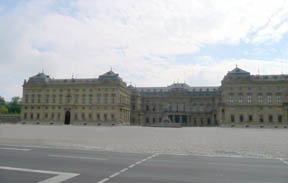
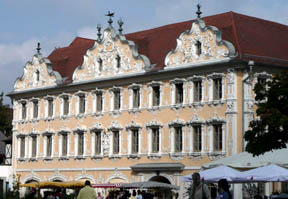 Wurzburg is the home of Julius Maximilians University where Wilhelm Conrad
Roentgen discovered the X-ray, and was awarded the first Nobel prize in physics.
Five other Nobel prize winners have graced the staff of this university since
this time. Today 23,000 students and 3000 scientists work at the three
institutes of higher learning in Wurzburg,
Wurzburg is the home of Julius Maximilians University where Wilhelm Conrad
Roentgen discovered the X-ray, and was awarded the first Nobel prize in physics.
Five other Nobel prize winners have graced the staff of this university since
this time. Today 23,000 students and 3000 scientists work at the three
institutes of higher learning in Wurzburg,
Friday afternoon, we took a motor coach to the medieval town of Rothenberg ob
der Tauber (above the Tauber) built from 1100 to 1400 a.d.. with city walls and
turrets still intact to this day.
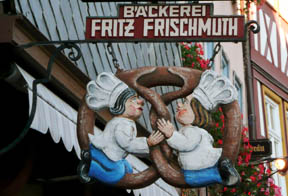 During the 30 Years War, the Catholic
Churches, which had been converted to Lutheran churches at the decree of the
city fathers, were seized by the Catholic armies and the town changed back to
Catholic. All the townsmen were rounded up by the conquering army and were
ordered to be killed. The doomed men asked for one glass of wine before their
execution, and they drank with their captors.
During the 30 Years War, the Catholic
Churches, which had been converted to Lutheran churches at the decree of the
city fathers, were seized by the Catholic armies and the town changed back to
Catholic. All the townsmen were rounded up by the conquering army and were
ordered to be killed. The doomed men asked for one glass of wine before their
execution, and they drank with their captors.
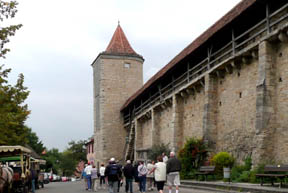 One thing led to another until a
wager was made that if one doomed man could drink a gallon of wine without
stopping, the execution would be spared. He accomplished this task, and a
commemorative monument was erected in the town square honoring this hero.
One thing led to another until a
wager was made that if one doomed man could drink a gallon of wine without
stopping, the execution would be spared. He accomplished this task, and a
commemorative monument was erected in the town square honoring this hero.
Rothenberg stands today exactly as it did in the middle ages, with towers and
fortified gates, 2 1/2 miles of battlements, magnificent homes and churches, and
a view of the Tauber River. Rothenberg is home to the most famous Christmas
store in the world, where Judy acquired two new ornaments for our Christmas
tree.
Returning to the Amadagio, we had an enjoyable late dinner and enjoyed a
classical concert by two local artists, playing a harp, flutes, and classical
guitar.
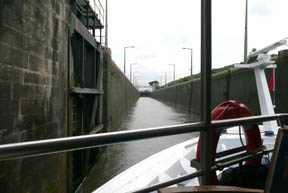
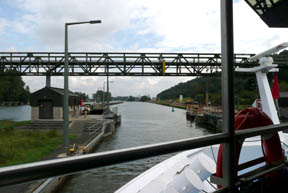 Saturday we enter the Main Danube Canal and reach an elevation of 1332 feet
above sea level as we cross the Swabian Alps. After we reach the high point of
our cruise, it is all down hill to the Danube river.
Saturday we enter the Main Danube Canal and reach an elevation of 1332 feet
above sea level as we cross the Swabian Alps. After we reach the high point of
our cruise, it is all down hill to the Danube river.
Rhine-Danube Adventure - Days 8-9: We reach the high point of our cruise
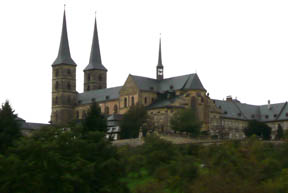
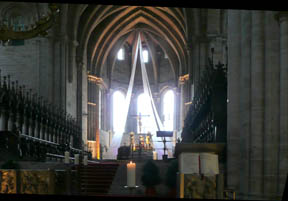 We began our morning leisurely cruising our last stretch of the Main River
until we reached the Main Danube Canal. We docked at Bamburg, a town of 70,000
inhabitants with a university of 9000 students and also 9 breweries in town and
81 others in the surrounding countryside which make over 200 varieties of beer.
We began our morning leisurely cruising our last stretch of the Main River
until we reached the Main Danube Canal. We docked at Bamburg, a town of 70,000
inhabitants with a university of 9000 students and also 9 breweries in town and
81 others in the surrounding countryside which make over 200 varieties of beer.
We then steamed up the Main-Danube canal which connects Bamburg on the Main
with Kelheim on the Danube River, permitting traffic to flow from the North Sea
to the Black Sea. The idea for this canal dates back to 793 when Charlemagne
excavated a canal between small tributaries of the Main and Danube. Heavy rains
caused the channel to collapse and the project was abandoned. In 1837 a
replacement canal was constructed along the present route of the canal, but it
was never able to compete with the railroads which had just been constructed
because of the 101 locks which caused extensive delays in transit.
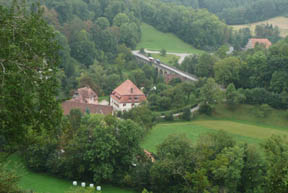
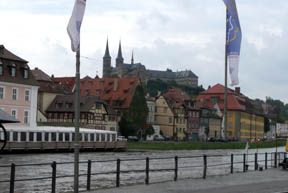 The current canal was constructed between 1960 and 1992, with only 16 locks,
and of a size large enough to handle bulk freight carriers. With the opening of
Eastern Europe, the passage of bulk materials from eastern Europe and finished
goods from the western countries to the east ensured success of this canal from
its opening. With the advent of tourism and river cruising along the rivers of
Europe, over 40 percent of traffic is now cruise ships, with this dominated by
Uniworld, Grand Circle and one other.
The current canal was constructed between 1960 and 1992, with only 16 locks,
and of a size large enough to handle bulk freight carriers. With the opening of
Eastern Europe, the passage of bulk materials from eastern Europe and finished
goods from the western countries to the east ensured success of this canal from
its opening. With the advent of tourism and river cruising along the rivers of
Europe, over 40 percent of traffic is now cruise ships, with this dominated by
Uniworld, Grand Circle and one other.
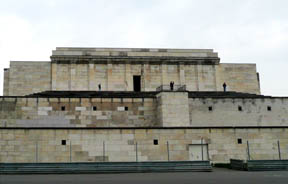
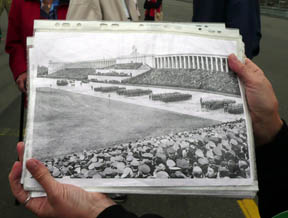 We stopped in Nuremberg, with 200,000 residents the second largest city in
Bavaria next to Munich. Hitler chose this city for the Nazi rallies between 1933
and 1938. We visited the infamous parade grounds which had over 250,000 people
in attendance for these Nazi rallies. At the end of WW-II, the Allies chose
Nuremberg for the Nuremberg trials of Nazi leaders. Of the 24 tried, 12 were
executed, 9 were given long term sentences or committed suicide, and three were
acquitted. The actual courtroom is now a working courtroom, and is only open to
tourists on weekends.
We stopped in Nuremberg, with 200,000 residents the second largest city in
Bavaria next to Munich. Hitler chose this city for the Nazi rallies between 1933
and 1938. We visited the infamous parade grounds which had over 250,000 people
in attendance for these Nazi rallies. At the end of WW-II, the Allies chose
Nuremberg for the Nuremberg trials of Nazi leaders. Of the 24 tried, 12 were
executed, 9 were given long term sentences or committed suicide, and three were
acquitted. The actual courtroom is now a working courtroom, and is only open to
tourists on weekends.
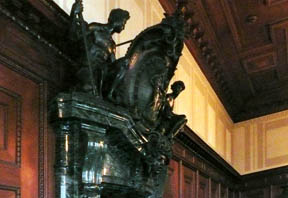
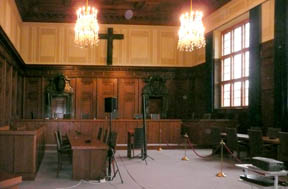 It is not lost that the residents of Nuremberg considered the war trials to
be a political show, and they denied any knowledge of the Nazi atrocities and
crimes against humanity. Some members of the younger generation even deny that
these crimes occurred.
It is not lost that the residents of Nuremberg considered the war trials to
be a political show, and they denied any knowledge of the Nazi atrocities and
crimes against humanity. Some members of the younger generation even deny that
these crimes occurred.
Leaving Nuremberg, we crossed the continental divide at 1332 feet above sea
level, and reached the high point of our cruise. As everything from this point
was all down hill, we locked down to the level of the Danube, and prepared to
stop on Monday in Regensburg on the Danube.
Rhine-Danube Adventure Day 10 - Regensburg
The Danube is the second longest river in Europe (I don't know what is the
longest) and the northernmost point of the river is Regensburg in Bavaria, where
a stone bridge was constructed over the Danube in 1135 linking the trade routes
from Northern Europe and Venice. Regensburg was established in 179 a.d. as a
Roman fort, and the town grew to over 20,000 during Roman occupation . In 530 it
became the capitol of Bavaria, and became the capitol of the Second Reich
(recalling Hitler established the Third Reich), a designation it maintained
until Napoleon overran it in 1803 and gave it to his ally Germany.
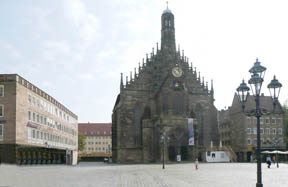
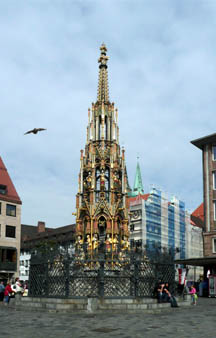 Regensburg suffered little damage from air raids in WW-II, and has an almost
intact medieval city centre. In the town center are two cathedrals, one of which
the present Pope Benedict XVI was archbishop of before he was elevated to his
current status, As he was Archbishop Ratzinger before his elevation, he is now
lovingly referred to as "Papa Ratzi" by the local press.
Regensburg suffered little damage from air raids in WW-II, and has an almost
intact medieval city centre. In the town center are two cathedrals, one of which
the present Pope Benedict XVI was archbishop of before he was elevated to his
current status, As he was Archbishop Ratzinger before his elevation, he is now
lovingly referred to as "Papa Ratzi" by the local press.
Our tour of the city included the Roman sites, medieval homes and castles,
and, of course the Brathaus where we enjoyed brats, sauerkraut, and sweet German
mustard for lunch.
We entered the beautiful blue Danube at this point. They say the Danube is
only blue if you are drunk or in love, to the rest of us it is a muddy brown
color.
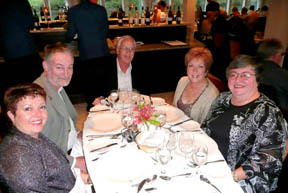
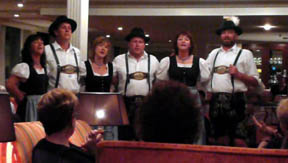 While we sleep tonight, we will sail to Passau, and then take a coach to
Salzburg, and then pick up our ship in Linz to continue to Vienna.
While we sleep tonight, we will sail to Passau, and then take a coach to
Salzburg, and then pick up our ship in Linz to continue to Vienna.
Rhine-Danube Adventure Day 11 - Salzburg in the Rain
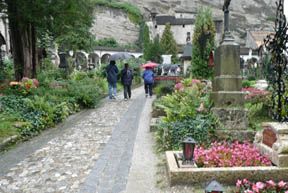
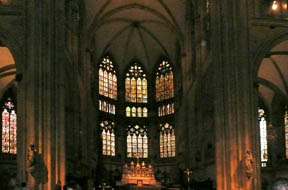 We began our day by docking in Passau, Germany, where the Danube joins with
the River INN and the River ILZ. We immediately board our bus for a two hour
drive to Salzburg, the magical town of Mozart and "The Sound of Music."
We began our day by docking in Passau, Germany, where the Danube joins with
the River INN and the River ILZ. We immediately board our bus for a two hour
drive to Salzburg, the magical town of Mozart and "The Sound of Music."
We arrive to the sound of rain and hail dancing on our bus, and "enjoy" a
walking tour of this city with over one hundred churches, castles, and palaces
which bear witness to the power of the ruling Salzburg archbishops.
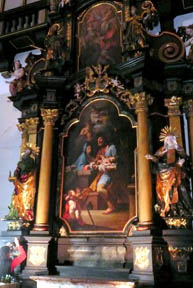
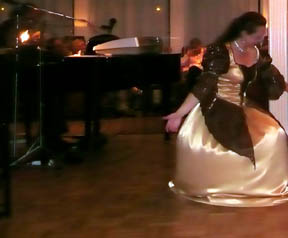 Wolfgang
Amadeus Mozart was born here in 1758, and he became famous throughout the world
both because of his genius and because of the sponsorship and financial support
of the ruling archbishop.
Wolfgang
Amadeus Mozart was born here in 1758, and he became famous throughout the world
both because of his genius and because of the sponsorship and financial support
of the ruling archbishop.
The city itself became famous when the Salzburg
Festival was founded here in 1920, and when the film "The Sound of Music" was
made in Salzburg in 1964 even more tourists came flocking to this city to see
the film locations as well as the music festivals.
Like most tourists, we had coffee and purchased our Mozart balls at the Cafe
Furst, and tasted a goulash, sausage and strudel lunch in one of the local
restaurants. We returned to our ship in Linz, and enjoyed an operatic concert
with Mozart music after a late dinner on board.
We continue our passage down the Danube as it winds slowly down its navigable
1,500 mile path from the Black Forest in Germany to the Black Sea, passing
through ten countries and diverse cultures, peoples and religions.
Rhine-Danube Adventure Day 12 - Melk and Durnstein
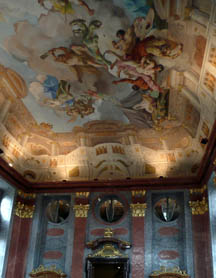
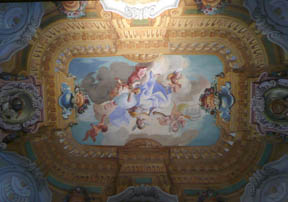 Along the Danube River in our way to Vienna, we stopped at Melk, the location
of Melk Abbey, the third most visited attraction in Austria, after the
Schoenbroen palace in Vienna and the fortress in Salzburg.
Along the Danube River in our way to Vienna, we stopped at Melk, the location
of Melk Abbey, the third most visited attraction in Austria, after the
Schoenbroen palace in Vienna and the fortress in Salzburg.
This Benedictine
Abbey which is still a working abbey, with its school, after over 900 years
since its foundation in 1089 a.d. defies superlatives in its accolades, as it
truly shows the best of glory and dignity of the baroque.
Rooms, libraries and
the church are decorated with sculptures, frescoes, and golden sculptures that
are beyond description.
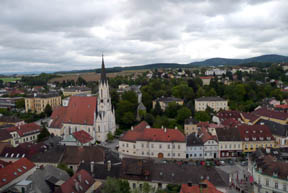
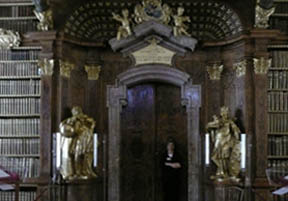 The world famous library with hand copied manuscripts
and books inspired Umberto Eco to write his book - The Name of the Rose - which
was later made into a movie starring Sean Connery.
The world famous library with hand copied manuscripts
and books inspired Umberto Eco to write his book - The Name of the Rose - which
was later made into a movie starring Sean Connery.
We returned to our ship and then cruised on the Danube through the Wachau
Valley with its castles and then stopped at the little village of Durnstein
where a visit into town by Judy (BJ stayed on board for a postprandial nap)
resulted in the tasting of some of the best of Austrian chocolates.
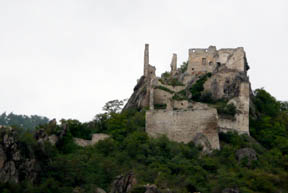
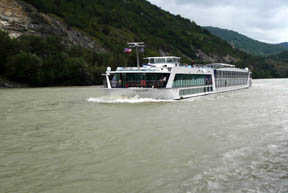
The castle
fortress above Durnstein was the place where Richard the Lion-Hearted was
imprisoned by the Babenberg duke Leopold V in 1193 until England paid a large
ransom for his release. The castle fortress is now in ruins, with just a wall
and some ramparts still in place.
We continue to the wine producing town of Weissenkirchen and dock for the
night before our departure for Vienna in the morning.
Rhine-Danube Adventure Day 13 - Vienna
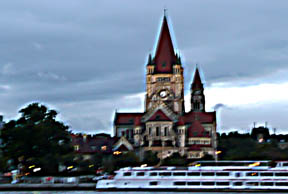 Ahhh Vienna! It is impossible to put words to describe the elegance of this
city, with every building looking like it came out of a museum, and its narrow
cobblestone streets adding even more to the excitement and splendor. We have
decided that we will be coming back as soon as we can to spend a week here to
immerse ourselves in this wonderful city.
Ahhh Vienna! It is impossible to put words to describe the elegance of this
city, with every building looking like it came out of a museum, and its narrow
cobblestone streets adding even more to the excitement and splendor. We have
decided that we will be coming back as soon as we can to spend a week here to
immerse ourselves in this wonderful city.
We began our day with a view of St. Stephan's Cathedral, with its 135 meter
spire and colorful roof composed of over 350,000 glazed tiles.
Walking in the
inner city, we spent time on Vienna's main pedestrian street called the
"Kaertnerstrasse," passing by the Opera House and the famous Sacher Hotel and
Cafe, as well as the fine shops which display goods which only the truly rich
and well endowed can afford.
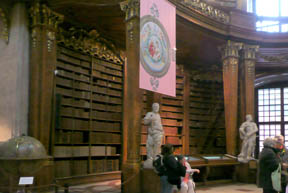
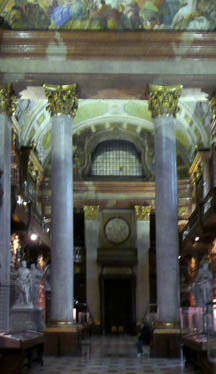 We entered the National Library with its rooms of over two million books
including manuscript, chart, music, globe and portrait collections. We could
have spent days just studying each room of this treasure built by the Habsburg
emperors.
We entered the National Library with its rooms of over two million books
including manuscript, chart, music, globe and portrait collections. We could
have spent days just studying each room of this treasure built by the Habsburg
emperors.
Leaving the Library, we walked past the Hofburg Palace complex and the
Spanish Riding School, the City Hall ("Rathous") and the university of Vienna,
the oldest in Europe, founded in 1325 and now having 85,000 students. Eight
million people live in Austria, with 1.8 million living in the city. The city
has acquired over 250,000 apartments in the city, and the waiting list for these
rent controlled domiciles is over 10 years long.
Next to Warsaw, Vienna had the largest Jewish population in Europe, with
200,000 living there before the Nazis expelled half of them and exterminated the
other half in concentration camps. Now the Jewish population in Vienna is about
10,000, with most of them engaged in banking and merchandising of fine art and
jewelry.
Over half of the city is green space, with many parks and, surprisingly
vineyards. Much of Austria's finest wine is produced right here in the city.
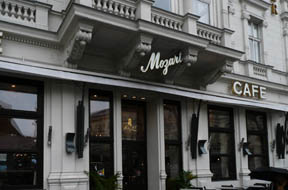
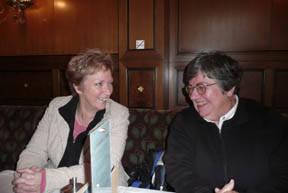
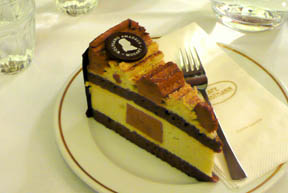 Our visit to Vienna included a mandatory stop at the Mozart Cafe where we had
coffee and Sacher Torte (at half the cost of the Sacher Cafe but identical in
quality.)
Our visit to Vienna included a mandatory stop at the Mozart Cafe where we had
coffee and Sacher Torte (at half the cost of the Sacher Cafe but identical in
quality.)
We then took a ride on horse coaches known as "Flakers" through old cobblestone
streets and small lanes, visiting places not possible on city tours. We finished
our day with a ride on the original Ferris wheel in the Prater park.
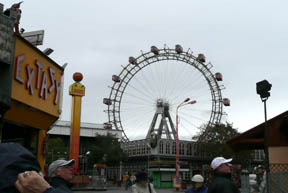
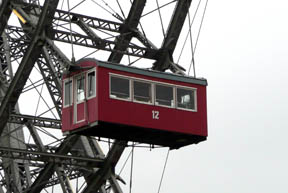 As we have now spent 12 days on board our river boat, there are a few people
who have become out of sorts. Here in Vienna, a physician service known as "Doc
around the Clock" visits tour boats and examines and prescribes to passengers,
at a mere cost of 165 euros for a 10 minute consultation.
As we have now spent 12 days on board our river boat, there are a few people
who have become out of sorts. Here in Vienna, a physician service known as "Doc
around the Clock" visits tour boats and examines and prescribes to passengers,
at a mere cost of 165 euros for a 10 minute consultation.
This is our third day of rain, and one of our fellow travelers is a Christian
minister. We asked him to put in a word with the Lord to stop the rain. His
reply was "I'm in sales, not in management!" As the Danube River is now rising
we are in danger of overflowing the locks and banks. For this reason we left
Vienna early and made our way to Bratislava in Slovakia a little early, and we
spent the night there rather than in Vienna.
Rhine-Danube Adventure Day 14 - Sloshing through Slovakia
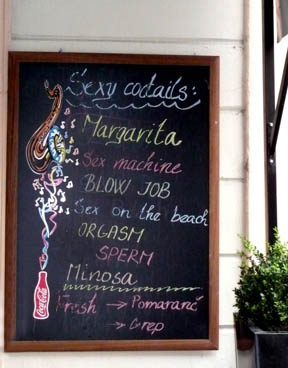
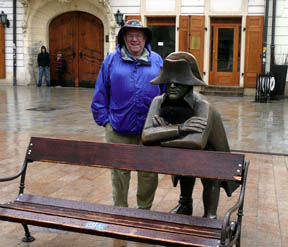 It is still raining, the Danube River is now over 10 feet above normal
levels, the temperature is down to 10 degrees C (45 degrees F) and the natives
are worried about global warming! We arrived here in Bratislava, Slovakia last
night, and because we are worried about the Danube rising above flood stage, we
will be leaving this afternoon to make our final passage to Budapest, Hungary.
It is still raining, the Danube River is now over 10 feet above normal
levels, the temperature is down to 10 degrees C (45 degrees F) and the natives
are worried about global warming! We arrived here in Bratislava, Slovakia last
night, and because we are worried about the Danube rising above flood stage, we
will be leaving this afternoon to make our final passage to Budapest, Hungary.
Although we Americans know little about Bratislava, formerly called Presburg,
it was the capitol of Hungary for over 1000 years when this territory was under
Hungarian rule.
Nineteen Hungarian rulers were crowned in Presburg, as Budapest
was under Turkish rule during this period. Slovakia and the Czech territory were
taken away from Austria-Hungary in 1919, and formed into the country of
Czechlovakia, which remained independent until annexed by the Nazis in 1939. It
was liberated by the Russians in 1945 on their way to Berlin, and the Slovaks
have always thought of the Russians as liberators, not invaders. Russia only
maintained a token force here during the cold war, as the Czechs were treated as
partners in the Eastern Bloc.
Bratislava is located on both sides of the Danube, just three miles from the
Austrian border and 12 miles from the Hungarian border. After WW-I, the
victorious allies did not know whether the city of Bratislava belonged to
Austria or Hungary, and was at first called Wilson City, after US president
Wilson.
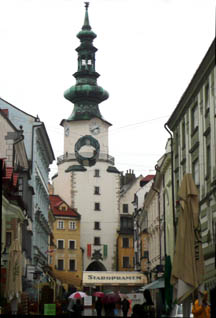
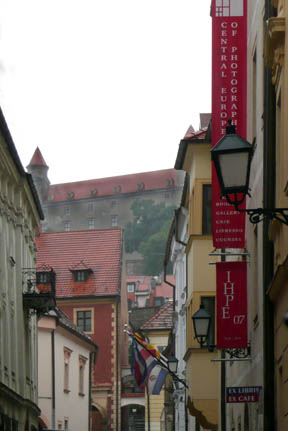 We walked in the rain through the old city of Bratislava, passing the
embassies of many countries, as well as the Opera House, university, town hall,
and private residences where Mozart, Beethoven, Liszt and Rubenstein once lived
or stayed while they were in town.
We walked in the rain through the old city of Bratislava, passing the
embassies of many countries, as well as the Opera House, university, town hall,
and private residences where Mozart, Beethoven, Liszt and Rubenstein once lived
or stayed while they were in town.
After WW-II Russian style apartment buildings
made of stark grey concrete were built on the south side of the river. This area
is now known as "Lego Land."
Our tour guide, a woman about 40, said that this generation enjoys the
freedom and ability to choose that have resulted from the fall of Communism, but
the old people long for the security that the communist government provided with
guaranteed jobs and income.
She was quite western in her speech, but when we
crossed an intersection, she said "Ready, steady, go" instead of "Ready, set,
go" as we would state.
After two hours of walking in the rain we returned through passport control
to our ship, and are now tucked in and are drying out.
Rhine-Danube Adventure Days 15-18 - Four Days in Budapest
Day 1
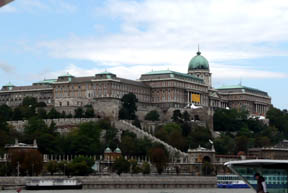 We arrived in Budapest during the night, and docked on the Buda side of the
Danube, under the shadow of the Castle Hill and the Royal Palace. Over 2
million of the 10 million citizens of Hungary live in Budapest. Originally
two cities of Buda and Pest, the cities were combined in 1873 to form a single
city, with the industry and commerce mainly on the flat Pest side, and the
better homes and castles and palaces on the hilly Buda side. Hungary, and
specifically the area around Budapest, was invaded by the Mongols under Genghis
Khan in the 13th Century, and the Tartar influence still is prominent in this
city.
We arrived in Budapest during the night, and docked on the Buda side of the
Danube, under the shadow of the Castle Hill and the Royal Palace. Over 2
million of the 10 million citizens of Hungary live in Budapest. Originally
two cities of Buda and Pest, the cities were combined in 1873 to form a single
city, with the industry and commerce mainly on the flat Pest side, and the
better homes and castles and palaces on the hilly Buda side. Hungary, and
specifically the area around Budapest, was invaded by the Mongols under Genghis
Khan in the 13th Century, and the Tartar influence still is prominent in this
city.
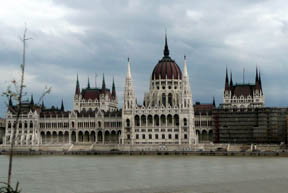 In the middle of the Danube River, there is a city park island named Margaret
Island, which was given to the people of Budapest by King Bela IV in 1869.
He named the park after his daughter Margaret, who lived in a convent her entire
life until she died at the age of 29, Margaret is said to have never
washed during her entire life! She must have really smelled so bad, how
could she have ever dreamed that she would capture a husband. During these
times, people of Hungary never took baths, they thought it was unhealthy.
In the middle of the Danube River, there is a city park island named Margaret
Island, which was given to the people of Budapest by King Bela IV in 1869.
He named the park after his daughter Margaret, who lived in a convent her entire
life until she died at the age of 29, Margaret is said to have never
washed during her entire life! She must have really smelled so bad, how
could she have ever dreamed that she would capture a husband. During these
times, people of Hungary never took baths, they thought it was unhealthy.
Over the past 10 years since the fall of communism, over 500 thousand people
have left Budapest to live in the country. There is a decline in
population in Hungary, and as an incentive to have more children, the Communist
government provided an incentive of a 20 percent down payment to any family who
would promise to have one or two babies within two years of buying a home.
With this incentive, almost every pair of newlyweds had two children within the
first two years of marriage, and once they got their home purchase down payment
confirmed, had no more children. After an
early breakfast, we took a water taxi to the Pest side of the Danube, and walked
to Vaci Street, which has been blocked off and pedestrianized and is lined on
both sides with little shops which sell handmade folk items, decorated boxes,
embroidered dresses, and of course, tablecloths which have been hand embroidered
by women who live in the countryside.
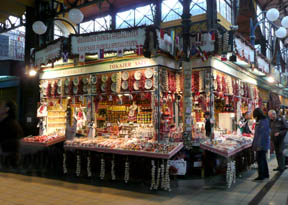
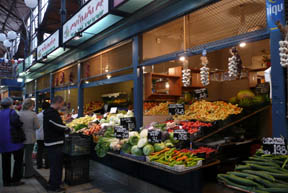 We continued to the end of Vaci Street to the Central Market, which looks a
lot like an old Victorian building, with cast iron support beams and two floors
around the walls with a center open space.
We continued to the end of Vaci Street to the Central Market, which looks a
lot like an old Victorian building, with cast iron support beams and two floors
around the walls with a center open space.
We found stalls selling fresh fish,
meat, vegetables and spices. On the second
floor there were Hungarian fast food cafes and stalls selling folk items and
more hand embroidered items.
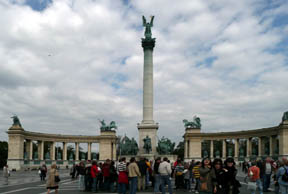
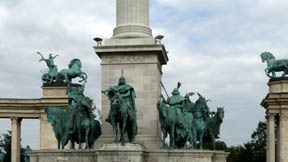 We went back to our cruise ship for
lunch, and then went on a bus tour
of Budapest, including Hero's Square and Andrassy
Boulevard lined with ornate buildings which were the homes of the rich and
famous in the 1890's. These buildings were taken over by the Communists
and were subdivided into as many as sixteen apartments during that era.
We went back to our cruise ship for
lunch, and then went on a bus tour
of Budapest, including Hero's Square and Andrassy
Boulevard lined with ornate buildings which were the homes of the rich and
famous in the 1890's. These buildings were taken over by the Communists
and were subdivided into as many as sixteen apartments during that era.
When the apartments were sold to the renters, they were responsible for building
maintenance on a joint basis, but with no money to do so, many of these are now
in a state of disrepair.
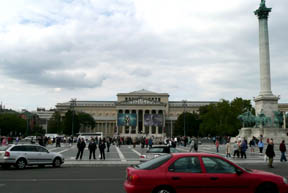
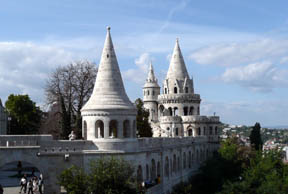 We motored by the public baths and
parks, as well as the
Parliament and Opera House. Returning to the Buda side, we drove up to the
Castle district, and stopped near Matyas church; and walked out on the Fisherman's
Bastion for an overall look at the entire city and the Danube River.
We motored by the public baths and
parks, as well as the
Parliament and Opera House. Returning to the Buda side, we drove up to the
Castle district, and stopped near Matyas church; and walked out on the Fisherman's
Bastion for an overall look at the entire city and the Danube River.
We stopped to look across the
Danube to view the Parliament building and take mandatory photographs of both
Judy and BJ on the Fisherman's Bastion, as well as a photo of our Amadagio
Aussie friends.
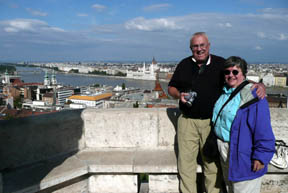
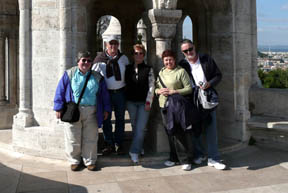 Returning to
our
cruise ship Amadagio for the last time, we enjoyed our Farewell
Dinner with our new Aussie
friends and were treated to Hungarian
folk entertainment before returning to our stateroom to pack our luggage for
disembarkation in the morning.
Returning to
our
cruise ship Amadagio for the last time, we enjoyed our Farewell
Dinner with our new Aussie
friends and were treated to Hungarian
folk entertainment before returning to our stateroom to pack our luggage for
disembarkation in the morning.
Day 2
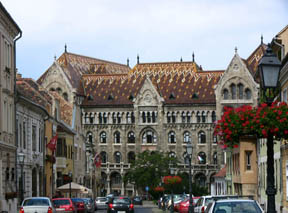
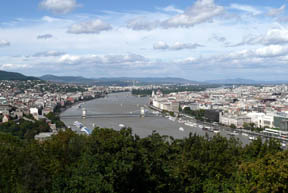 We shared a
Final
breakfast with our new friends before taking a
Taxi to
the Budapest Hilton which is located in the Castle District overlooking the
Danube River. We checked in, then went to Sunday
Mass at Matyas
Church and had a light snack before meeting with our personal tour guide
Gabriella.
We shared a
Final
breakfast with our new friends before taking a
Taxi to
the Budapest Hilton which is located in the Castle District overlooking the
Danube River. We checked in, then went to Sunday
Mass at Matyas
Church and had a light snack before meeting with our personal tour guide
Gabriella.
We walked through Castle District,
stopped to see a bombed
out church and the Plague
Statue, then got into Gabriella's car driven by her 18 year old son and drove by
the castle area, the Gellart Hotel and Spa.
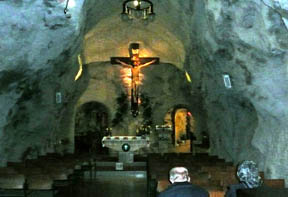
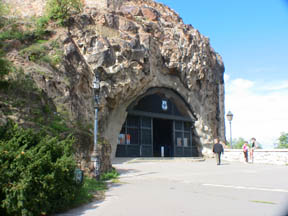 We
then drove down Castle Hill to the Danube riverbank, and went to the famous Cave
Church where we stopped and went inside to see the chapels and main worship hall
located in the underground caverns.
We
then drove down Castle Hill to the Danube riverbank, and went to the famous Cave
Church where we stopped and went inside to see the chapels and main worship hall
located in the underground caverns.
We drove up to
Liberation Monument on the top of Gellart Hill in Buda. This monument was
set up to commemorate the liberation of Hungary by the Russian Army in 1945.
The central figure is a woman holding a palm leaf.
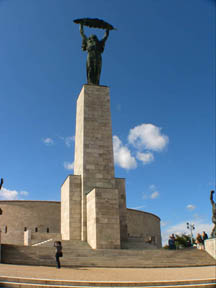
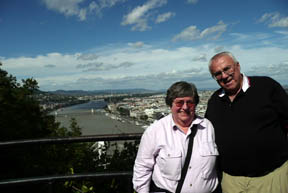 The Russians came as
liberators, but during the cold war communist oppression just replaced Nazi
terrorism, and when the communist regime collapsed, all references to Russian
liberation, including
Russian text,
were removed from the monument in 1992.
The Russians came as
liberators, but during the cold war communist oppression just replaced Nazi
terrorism, and when the communist regime collapsed, all references to Russian
liberation, including
Russian text,
were removed from the monument in 1992.
The view of both sides of the
Danube is spectacular from this location.
We then went into Pest and stopped at the Szechenyi
Public Baths and Varosliget
Park with its assortment of carnival rides.
We
drank mineral water from the spa, and stopped for lunch at Szechenyi baths
and had some Goulash Soup.
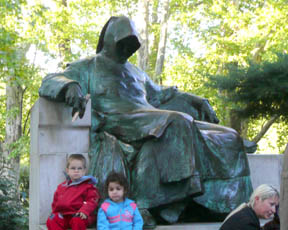 During lunch, Judy brought out
military papers of Judy’s grandfather and Gabriella and her son translated the
text written in old Hungarian script during the period of his enlistment as a
Hussar from 1902 to 1904. He had volunteered for a 12 year enlistment as a
mounted horseman, but after a year, his performance appraisal stated that he was
a better tailor than a horseman, and he worked to support the mounted Hussars
from that point forward. In 1904 he requested and was granted a leave to
visit relatives in Cincinnati, Ohio in the USA, and he went across the Atlantic
Ocean, never to return to Hungary. Dunning letters were sent to him from
the Hungarian Army in 1905, but it appears that he ignored them as he initiated
his career as a tailor in Cincinnati.
During lunch, Judy brought out
military papers of Judy’s grandfather and Gabriella and her son translated the
text written in old Hungarian script during the period of his enlistment as a
Hussar from 1902 to 1904. He had volunteered for a 12 year enlistment as a
mounted horseman, but after a year, his performance appraisal stated that he was
a better tailor than a horseman, and he worked to support the mounted Hussars
from that point forward. In 1904 he requested and was granted a leave to
visit relatives in Cincinnati, Ohio in the USA, and he went across the Atlantic
Ocean, never to return to Hungary. Dunning letters were sent to him from
the Hungarian Army in 1905, but it appears that he ignored them as he initiated
his career as a tailor in Cincinnati.
After lunch, we walked
through Vajdahunyad Castle, which is a complex of buildings representing a
variety of architectural styles, and visited the statue of
"anonymous" in the park.

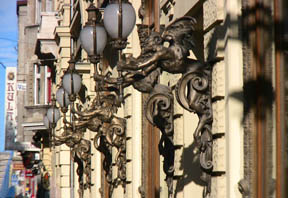
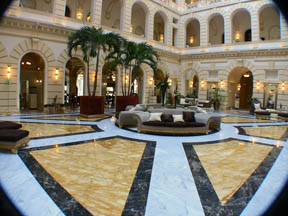 We drove back to the central city down
Andrassy Blvd, looking
at the splendor of old homes
where the rich and famous lived during the height of Hungarian prosperity in the
1990s. We walked around and then inside one grand hotel that has the main
lobby and dining room mad of marble with gold covered fixtures and decorations.
We drove back to the central city down
Andrassy Blvd, looking
at the splendor of old homes
where the rich and famous lived during the height of Hungarian prosperity in the
1990s. We walked around and then inside one grand hotel that has the main
lobby and dining room mad of marble with gold covered fixtures and decorations.
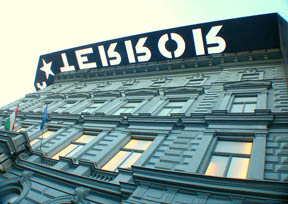 When the communists took over the country in 1945, these
magnificent homes were converted into apartments for as many as 10 or more
families. Later, these state owned apartments were sold to the residents
as condominiums, with the new owners responsible for maintenance and
restoration. Restoration has been slow in coming, but many are now
restored. We stopped at one home which has been converted to a Postal museum,
but it gave us a good look at what the old homes looked like despite the fact
that the main rooms have been converted to the Postal museum.
When the communists took over the country in 1945, these
magnificent homes were converted into apartments for as many as 10 or more
families. Later, these state owned apartments were sold to the residents
as condominiums, with the new owners responsible for maintenance and
restoration. Restoration has been slow in coming, but many are now
restored. We stopped at one home which has been converted to a Postal museum,
but it gave us a good look at what the old homes looked like despite the fact
that the main rooms have been converted to the Postal museum.
We stopped at the Budapest Opera house, and looked in
the lobby to see the ornateness of the inside.
The Terror Museum was our
next stop, where we saw the documentation of both the Nazi and Communist
oppression of the citizens, including the torture and forced confessions that
were done there.
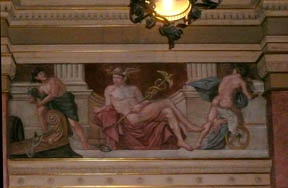
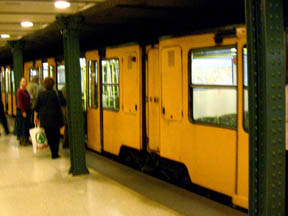 We stopped at the original subway station,
with decorated frescoes in the ceilings of the stations. Gabriella
taught us how to
use the public transportation system which is comprised of trams, subways, and
busses, all readily accessible to visitors for a single inexpensive daily pass.
There are no tills or toll booths, everything is on the honor system, with
periodic spot checks made by a few officers. It really works well, and
there is little or no cheating, as the fines for being without a pass are quite
severe. We finished our day with Gabriella with a drive by Parliament and St.
Stephan's Cathedral, vowing to come back on our own during the next two days.
We stopped at the original subway station,
with decorated frescoes in the ceilings of the stations. Gabriella
taught us how to
use the public transportation system which is comprised of trams, subways, and
busses, all readily accessible to visitors for a single inexpensive daily pass.
There are no tills or toll booths, everything is on the honor system, with
periodic spot checks made by a few officers. It really works well, and
there is little or no cheating, as the fines for being without a pass are quite
severe. We finished our day with Gabriella with a drive by Parliament and St.
Stephan's Cathedral, vowing to come back on our own during the next two days.
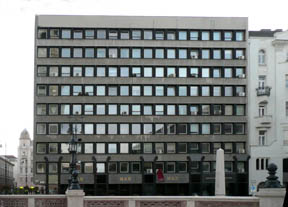
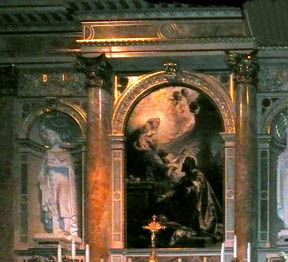 In
front of St. Stephans Cathedral is a building built by the communist government
during the Cold War. The Architecture is stark grey, in contrast to the
ornate architecture of the
romantic period of
Budapest.
In
front of St. Stephans Cathedral is a building built by the communist government
during the Cold War. The Architecture is stark grey, in contrast to the
ornate architecture of the
romantic period of
Budapest.
Returning to the Castle District, we had dinner at a local restaurant before
returning to the Hilton Hotel.
Day 3
We
slept in, then took a bus and tram to the Parliament building
but it was closed to visitors because Parliament was in session.
We walked around the outside and admired the building structure
itself.
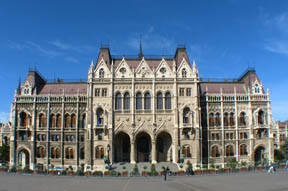
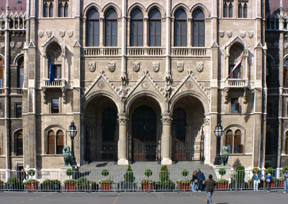 Budapest
was united from three cities in 1873 and seven years later the
National Assembly resolved to establish a new, representative
Parliament Building, expressing the sovereignty of the nation. A
competition was published, which was won by Imre Steindl, but
the plans of the other two competitors were also constructed,
facing the Parliament: one serves today as the Ethnographical
Museum, the other as the Ministry of Agriculture.
Budapest
was united from three cities in 1873 and seven years later the
National Assembly resolved to establish a new, representative
Parliament Building, expressing the sovereignty of the nation. A
competition was published, which was won by Imre Steindl, but
the plans of the other two competitors were also constructed,
facing the Parliament: one serves today as the Ethnographical
Museum, the other as the Ministry of Agriculture.
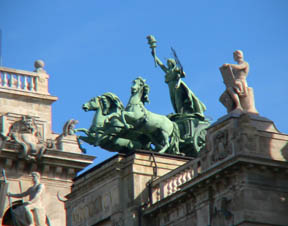 Construction
from the winning plan was started in 1885 and the building was
inaugurated on the 1000th anniversary of the country in 1896,
and completed in 1904. (It is to be noted that the architect of
the building went blind before its completion.) There were
about one thousand people working on its construction in which
40 million bricks, half a million precious stones and 40 kg gold
were used.
Construction
from the winning plan was started in 1885 and the building was
inaugurated on the 1000th anniversary of the country in 1896,
and completed in 1904. (It is to be noted that the architect of
the building went blind before its completion.) There were
about one thousand people working on its construction in which
40 million bricks, half a million precious stones and 40 kg gold
were used.
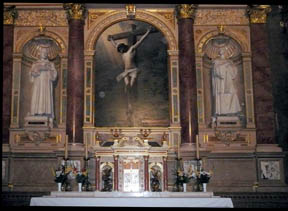
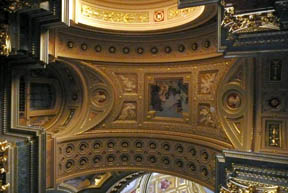 We walked to St Stephens
Basilica, toured the inside. The church is built in neoclassic style.
We walked to St Stephens
Basilica, toured the inside. The church is built in neoclassic style.
Statues on the
exterior shows the twelve Apostles, the four Evangelists etc. The interior is
decorated with work of arts made by 19th century Hungarian artists.
This
church is said to be second in size only to St. Peter's in Rome and can
allegedly hold 7,000 people. It was completed in 1905 and underwent
cleaning and restoration work for eight years. This work was completed in 2002. The cathedral has a height of 96
meters - exactly the same as the
Parliament building.
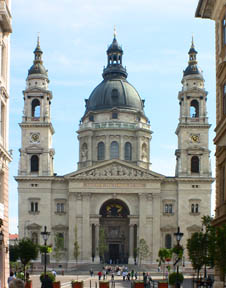
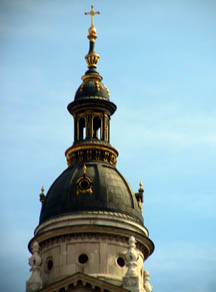
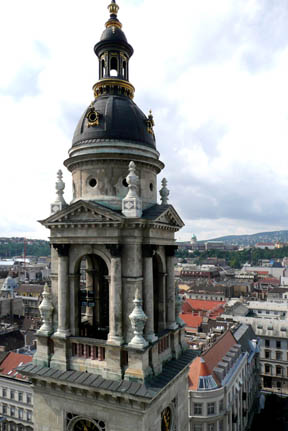
It took
over 50 years to build the Basilica, which was completed in
1905. Three leading
architects, two of whom died before work was finished, presided over its
construction. The delay was due in large part to the collapse of the
dome in 1868, requiring complete rebuilding from the ground up.
After
its completion, St. Stephen's was considered so sturdy that important
documents and artworks were stored in it during the World War II
bombings.
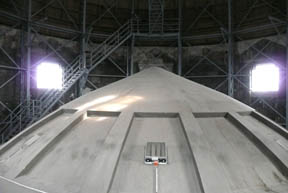
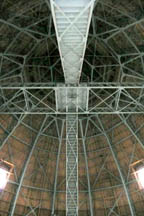 We took an elevator tour to the inside of the
dome and walked out on the balcony and had a magnificent view of the city as
well as the Buda side with its hills and castle and monuments.
We took an elevator tour to the inside of the
dome and walked out on the balcony and had a magnificent view of the city as
well as the Buda side with its hills and castle and monuments.
The front of the church graces the colorful and grand Szent István tér (
St.
Stephen's Square), where travelers sip their coffee in open-air
cafes.
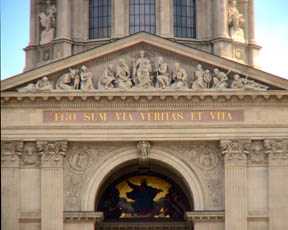 The bust above the main entrance is of
King Stephen, Hungary's first
Christian king.
The bust above the main entrance is of
King Stephen, Hungary's first
Christian king.
Inside the church, in the Chapel of the Holy Right (Szent
Jobb Kápolna), you can see Hungarian Catholicism's most cherished holy
relic:
the mummified hand of St. Stephen himself, which is paraded around the
city on his name day.
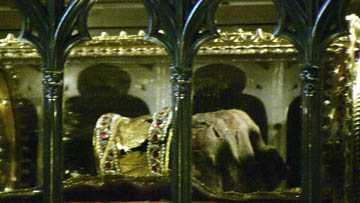
In the entrance foyer of St. Stephens Cathedral is a statue of Joseph, Cardinal Mindszenty,
Archbishop of Budapest and Primate of Hungary, who was a fanatical
"creature" of Pope Pius XII, who used him to further his religious and political
schemes in Central Europe.
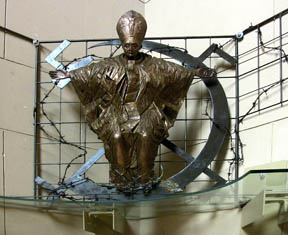 With the connivance of Pius and of
nationalistic Catholic elements, Mindszenty, immediately after World
War II, became the centre of a plot to overthrow the Government and
to restore a Catholic Monarchy in Hungary, with himself as Regent. The plot failed. Mindszenty was
jailed (1946). Ten years later Mindszenty became
once more the focus of the Revolution. He returned to Budapest...the
Capital, escorted by three Hungarian tanks...(October 1956) to head
a new Hungarian Government, as the only public figure to command
wide popular support. The uprising, however, proved another
failure. It was crushed by a ruthless Russian military intervention. Mindszenty took refuge in the USA
Legation of Budapest, where he was a "guest" for more than twelve
long years (1956-1968), notwithstanding USA and Vatican pressure to
dislodge him.
With the connivance of Pius and of
nationalistic Catholic elements, Mindszenty, immediately after World
War II, became the centre of a plot to overthrow the Government and
to restore a Catholic Monarchy in Hungary, with himself as Regent. The plot failed. Mindszenty was
jailed (1946). Ten years later Mindszenty became
once more the focus of the Revolution. He returned to Budapest...the
Capital, escorted by three Hungarian tanks...(October 1956) to head
a new Hungarian Government, as the only public figure to command
wide popular support. The uprising, however, proved another
failure. It was crushed by a ruthless Russian military intervention. Mindszenty took refuge in the USA
Legation of Budapest, where he was a "guest" for more than twelve
long years (1956-1968), notwithstanding USA and Vatican pressure to
dislodge him.


 It took
over 50 years to build the Basilica, which was completed in
1905. Three leading
architects, two of whom died before work was finished, presided over its
construction. The delay was due in large part to the collapse of the
dome in 1868, requiring complete rebuilding from the ground up.
It took
over 50 years to build the Basilica, which was completed in
1905. Three leading
architects, two of whom died before work was finished, presided over its
construction. The delay was due in large part to the collapse of the
dome in 1868, requiring complete rebuilding from the ground up. We have a good night sleep and then have a sightseeing bus and canal boat
tour of the city center and historical district. Amsterdam has 750,000 residents
and 600,000 bicycles which you can buy used at the flea market for 35 euros. You
then buy a 100 Euro lock, park the bicycle at work or school where it can get
stolen. You then go back to the flea market and buy the same bicycle back for
another 35 Euro -- the Dutch way of recycling.
We have a good night sleep and then have a sightseeing bus and canal boat
tour of the city center and historical district. Amsterdam has 750,000 residents
and 600,000 bicycles which you can buy used at the flea market for 35 euros. You
then buy a 100 Euro lock, park the bicycle at work or school where it can get
stolen. You then go back to the flea market and buy the same bicycle back for
another 35 Euro -- the Dutch way of recycling.
 d one at a time to clean out
the bicycles, Frigidaires etc. which have been dropped in or lost. There are
about 2500 licensed houseboats docked along the canals, and these houseboats are
connected to the city water, power, and sewer system. When you can find one, the
houseboats cost about 200,000 euros, and the waiting time for dock space is up
to 10 years.
d one at a time to clean out
the bicycles, Frigidaires etc. which have been dropped in or lost. There are
about 2500 licensed houseboats docked along the canals, and these houseboats are
connected to the city water, power, and sewer system. When you can find one, the
houseboats cost about 200,000 euros, and the waiting time for dock space is up
to 10 years.


 The word "Cologne" comes from the Latin "Colone" meaning colony. It was
founded by the Roman empress Agropina who assumed that title after she poisoned
her husband. Here mushrooms are still eaten freely to this day, but you must pay
before you eat.
The word "Cologne" comes from the Latin "Colone" meaning colony. It was
founded by the Roman empress Agropina who assumed that title after she poisoned
her husband. Here mushrooms are still eaten freely to this day, but you must pay
before you eat.  Cologne people are more Italian than German due to the more than 500 years of
Roman influence. They appreciated JFK visiting here as well as Berlin, where he
declared "Ich bien ein Berliner." When President Clinton visited Cologne during
his presidency, he stood up in front of the admiring crowd and declared "Ich
bien ein Kolshe" which means "I am a beer!"
Cologne people are more Italian than German due to the more than 500 years of
Roman influence. They appreciated JFK visiting here as well as Berlin, where he
declared "Ich bien ein Berliner." When President Clinton visited Cologne during
his presidency, he stood up in front of the admiring crowd and declared "Ich
bien ein Kolshe" which means "I am a beer!"
 As was Westminster Cathedral in London, this cathedral was not bombed by the
Allies during WW-II, although the stained glass windows were removed before the
war and stored safely underground until that conflict was over.
As was Westminster Cathedral in London, this cathedral was not bombed by the
Allies during WW-II, although the stained glass windows were removed before the
war and stored safely underground until that conflict was over.



 At about 1400 hours, we docked at Mainz, the crossroads of the Rhine, where
the Main river joins the Rhine. The Rhine is not the longest but it is the
busiest river in the world, with an average of over 300 commercial ships a day
passing by Mainz, on their way between Basel Switzerland and Amsterdam and the
sea. Fifty miles upstream of Mainz is the town of Worms, where Martin Luther
published his famous manifesto and initiated the Reformation. Eight miles from
Mainz is the US Air Force base and military hospital at Wiesbaden, and Frankfurt
International Airport is only 10 miles away, so Mainz is where pilots and flight
attendants stay between flights.
At about 1400 hours, we docked at Mainz, the crossroads of the Rhine, where
the Main river joins the Rhine. The Rhine is not the longest but it is the
busiest river in the world, with an average of over 300 commercial ships a day
passing by Mainz, on their way between Basel Switzerland and Amsterdam and the
sea. Fifty miles upstream of Mainz is the town of Worms, where Martin Luther
published his famous manifesto and initiated the Reformation. Eight miles from
Mainz is the US Air Force base and military hospital at Wiesbaden, and Frankfurt
International Airport is only 10 miles away, so Mainz is where pilots and flight
attendants stay between flights.






 At our evening presentation by
our cruise director, he read suggestions made by our fellow passengers as to how
to make our cruise more pleasurable. The best suggestion was to serve the
gentlemen hot chocolate and Viagra before bedtime, the hot chocolate to aid in
sleeping, and the Viagra to help them from falling out of the bed.
At our evening presentation by
our cruise director, he read suggestions made by our fellow passengers as to how
to make our cruise more pleasurable. The best suggestion was to serve the
gentlemen hot chocolate and Viagra before bedtime, the hot chocolate to aid in
sleeping, and the Viagra to help them from falling out of the bed.
 On Thursday and Friday we cruised up the Main River, smaller and cozier than
the Rhine, and with much less waterway traffic as well. Along its banks lie
quaint villages and picturesque homes, as well as riverside trailer parks filled
with caravans (camper trailers in the USA) where mostly retired couples sit on
lawn chairs and watch the river traffic.
On Thursday and Friday we cruised up the Main River, smaller and cozier than
the Rhine, and with much less waterway traffic as well. Along its banks lie
quaint villages and picturesque homes, as well as riverside trailer parks filled
with caravans (camper trailers in the USA) where mostly retired couples sit on
lawn chairs and watch the river traffic.
 Continuing upstream on the Main, we stopped at Wertheim, which is the glass
blowing capitol of Germany. We walked to the Marktplatz (Market Square) and
visited shops and a cafe where we had coffee and watched the locals go about
their daily shopping and baby carriage strolling.
Continuing upstream on the Main, we stopped at Wertheim, which is the glass
blowing capitol of Germany. We walked to the Marktplatz (Market Square) and
visited shops and a cafe where we had coffee and watched the locals go about
their daily shopping and baby carriage strolling. 
 Wurzburg is the home of Julius Maximilians University where Wilhelm Conrad
Roentgen discovered the X-ray, and was awarded the first Nobel prize in physics.
Five other Nobel prize winners have graced the staff of this university since
this time. Today 23,000 students and 3000 scientists work at the three
institutes of higher learning in Wurzburg,
Wurzburg is the home of Julius Maximilians University where Wilhelm Conrad
Roentgen discovered the X-ray, and was awarded the first Nobel prize in physics.
Five other Nobel prize winners have graced the staff of this university since
this time. Today 23,000 students and 3000 scientists work at the three
institutes of higher learning in Wurzburg,  During the 30 Years War, the Catholic
Churches, which had been converted to Lutheran churches at the decree of the
city fathers, were seized by the Catholic armies and the town changed back to
Catholic. All the townsmen were rounded up by the conquering army and were
ordered to be killed. The doomed men asked for one glass of wine before their
execution, and they drank with their captors.
During the 30 Years War, the Catholic
Churches, which had been converted to Lutheran churches at the decree of the
city fathers, were seized by the Catholic armies and the town changed back to
Catholic. All the townsmen were rounded up by the conquering army and were
ordered to be killed. The doomed men asked for one glass of wine before their
execution, and they drank with their captors.  One thing led to another until a
wager was made that if one doomed man could drink a gallon of wine without
stopping, the execution would be spared. He accomplished this task, and a
commemorative monument was erected in the town square honoring this hero.
One thing led to another until a
wager was made that if one doomed man could drink a gallon of wine without
stopping, the execution would be spared. He accomplished this task, and a
commemorative monument was erected in the town square honoring this hero.
 Saturday we enter the Main Danube Canal and reach an elevation of 1332 feet
above sea level as we cross the Swabian Alps. After we reach the high point of
our cruise, it is all down hill to the Danube river.
Saturday we enter the Main Danube Canal and reach an elevation of 1332 feet
above sea level as we cross the Swabian Alps. After we reach the high point of
our cruise, it is all down hill to the Danube river.
 We began our morning leisurely cruising our last stretch of the Main River
until we reached the Main Danube Canal. We docked at Bamburg, a town of 70,000
inhabitants with a university of 9000 students and also 9 breweries in town and
81 others in the surrounding countryside which make over 200 varieties of beer.
We began our morning leisurely cruising our last stretch of the Main River
until we reached the Main Danube Canal. We docked at Bamburg, a town of 70,000
inhabitants with a university of 9000 students and also 9 breweries in town and
81 others in the surrounding countryside which make over 200 varieties of beer.
 The current canal was constructed between 1960 and 1992, with only 16 locks,
and of a size large enough to handle bulk freight carriers. With the opening of
Eastern Europe, the passage of bulk materials from eastern Europe and finished
goods from the western countries to the east ensured success of this canal from
its opening. With the advent of tourism and river cruising along the rivers of
Europe, over 40 percent of traffic is now cruise ships, with this dominated by
Uniworld, Grand Circle and one other.
The current canal was constructed between 1960 and 1992, with only 16 locks,
and of a size large enough to handle bulk freight carriers. With the opening of
Eastern Europe, the passage of bulk materials from eastern Europe and finished
goods from the western countries to the east ensured success of this canal from
its opening. With the advent of tourism and river cruising along the rivers of
Europe, over 40 percent of traffic is now cruise ships, with this dominated by
Uniworld, Grand Circle and one other.
 We stopped in Nuremberg, with 200,000 residents the second largest city in
Bavaria next to Munich. Hitler chose this city for the Nazi rallies between 1933
and 1938. We visited the infamous parade grounds which had over 250,000 people
in attendance for these Nazi rallies. At the end of WW-II, the Allies chose
Nuremberg for the Nuremberg trials of Nazi leaders. Of the 24 tried, 12 were
executed, 9 were given long term sentences or committed suicide, and three were
acquitted. The actual courtroom is now a working courtroom, and is only open to
tourists on weekends.
We stopped in Nuremberg, with 200,000 residents the second largest city in
Bavaria next to Munich. Hitler chose this city for the Nazi rallies between 1933
and 1938. We visited the infamous parade grounds which had over 250,000 people
in attendance for these Nazi rallies. At the end of WW-II, the Allies chose
Nuremberg for the Nuremberg trials of Nazi leaders. Of the 24 tried, 12 were
executed, 9 were given long term sentences or committed suicide, and three were
acquitted. The actual courtroom is now a working courtroom, and is only open to
tourists on weekends.
 It is not lost that the residents of Nuremberg considered the war trials to
be a political show, and they denied any knowledge of the Nazi atrocities and
crimes against humanity. Some members of the younger generation even deny that
these crimes occurred.
It is not lost that the residents of Nuremberg considered the war trials to
be a political show, and they denied any knowledge of the Nazi atrocities and
crimes against humanity. Some members of the younger generation even deny that
these crimes occurred.
 Regensburg suffered little damage from air raids in WW-II, and has an almost
intact medieval city centre. In the town center are two cathedrals, one of which
the present Pope Benedict XVI was archbishop of before he was elevated to his
current status, As he was Archbishop Ratzinger before his elevation, he is now
lovingly referred to as "Papa Ratzi" by the local press.
Regensburg suffered little damage from air raids in WW-II, and has an almost
intact medieval city centre. In the town center are two cathedrals, one of which
the present Pope Benedict XVI was archbishop of before he was elevated to his
current status, As he was Archbishop Ratzinger before his elevation, he is now
lovingly referred to as "Papa Ratzi" by the local press.
 While we sleep tonight, we will sail to Passau, and then take a coach to
Salzburg, and then pick up our ship in Linz to continue to Vienna.
While we sleep tonight, we will sail to Passau, and then take a coach to
Salzburg, and then pick up our ship in Linz to continue to Vienna.
 We began our day by docking in Passau, Germany, where the Danube joins with
the River INN and the River ILZ. We immediately board our bus for a two hour
drive to Salzburg, the magical town of Mozart and "The Sound of Music."
We began our day by docking in Passau, Germany, where the Danube joins with
the River INN and the River ILZ. We immediately board our bus for a two hour
drive to Salzburg, the magical town of Mozart and "The Sound of Music."
 Wolfgang
Amadeus Mozart was born here in 1758, and he became famous throughout the world
both because of his genius and because of the sponsorship and financial support
of the ruling archbishop.
Wolfgang
Amadeus Mozart was born here in 1758, and he became famous throughout the world
both because of his genius and because of the sponsorship and financial support
of the ruling archbishop. 
 Along the Danube River in our way to Vienna, we stopped at Melk, the location
of Melk Abbey, the third most visited attraction in Austria, after the
Schoenbroen palace in Vienna and the fortress in Salzburg.
Along the Danube River in our way to Vienna, we stopped at Melk, the location
of Melk Abbey, the third most visited attraction in Austria, after the
Schoenbroen palace in Vienna and the fortress in Salzburg. 
 The world famous library with hand copied manuscripts
and books inspired Umberto Eco to write his book - The Name of the Rose - which
was later made into a movie starring Sean Connery.
The world famous library with hand copied manuscripts
and books inspired Umberto Eco to write his book - The Name of the Rose - which
was later made into a movie starring Sean Connery.

 Ahhh Vienna! It is impossible to put words to describe the elegance of this
city, with every building looking like it came out of a museum, and its narrow
cobblestone streets adding even more to the excitement and splendor. We have
decided that we will be coming back as soon as we can to spend a week here to
immerse ourselves in this wonderful city.
Ahhh Vienna! It is impossible to put words to describe the elegance of this
city, with every building looking like it came out of a museum, and its narrow
cobblestone streets adding even more to the excitement and splendor. We have
decided that we will be coming back as soon as we can to spend a week here to
immerse ourselves in this wonderful city.
 We entered the National Library with its rooms of over two million books
including manuscript, chart, music, globe and portrait collections. We could
have spent days just studying each room of this treasure built by the Habsburg
emperors.
We entered the National Library with its rooms of over two million books
including manuscript, chart, music, globe and portrait collections. We could
have spent days just studying each room of this treasure built by the Habsburg
emperors.

 Our visit to Vienna included a mandatory stop at the Mozart Cafe where we had
coffee and Sacher Torte (at half the cost of the Sacher Cafe but identical in
quality.)
Our visit to Vienna included a mandatory stop at the Mozart Cafe where we had
coffee and Sacher Torte (at half the cost of the Sacher Cafe but identical in
quality.)
 As we have now spent 12 days on board our river boat, there are a few people
who have become out of sorts. Here in Vienna, a physician service known as "Doc
around the Clock" visits tour boats and examines and prescribes to passengers,
at a mere cost of 165 euros for a 10 minute consultation.
As we have now spent 12 days on board our river boat, there are a few people
who have become out of sorts. Here in Vienna, a physician service known as "Doc
around the Clock" visits tour boats and examines and prescribes to passengers,
at a mere cost of 165 euros for a 10 minute consultation.
 It is still raining, the Danube River is now over 10 feet above normal
levels, the temperature is down to 10 degrees C (45 degrees F) and the natives
are worried about global warming! We arrived here in Bratislava, Slovakia last
night, and because we are worried about the Danube rising above flood stage, we
will be leaving this afternoon to make our final passage to Budapest, Hungary.
It is still raining, the Danube River is now over 10 feet above normal
levels, the temperature is down to 10 degrees C (45 degrees F) and the natives
are worried about global warming! We arrived here in Bratislava, Slovakia last
night, and because we are worried about the Danube rising above flood stage, we
will be leaving this afternoon to make our final passage to Budapest, Hungary.
 We walked in the rain through the old city of Bratislava, passing the
embassies of many countries, as well as the Opera House, university, town hall,
and private residences where Mozart, Beethoven, Liszt and Rubenstein once lived
or stayed while they were in town.
We walked in the rain through the old city of Bratislava, passing the
embassies of many countries, as well as the Opera House, university, town hall,
and private residences where Mozart, Beethoven, Liszt and Rubenstein once lived
or stayed while they were in town.  We arrived in Budapest during the night, and docked on the Buda side of the
Danube, under the shadow of the Castle Hill and the Royal Palace. Over 2
million of the 10 million citizens of Hungary live in Budapest. Originally
two cities of Buda and Pest, the cities were combined in 1873 to form a single
city, with the industry and commerce mainly on the flat Pest side, and the
better homes and castles and palaces on the hilly Buda side. Hungary, and
specifically the area around Budapest, was invaded by the Mongols under Genghis
Khan in the 13th Century, and the Tartar influence still is prominent in this
city.
We arrived in Budapest during the night, and docked on the Buda side of the
Danube, under the shadow of the Castle Hill and the Royal Palace. Over 2
million of the 10 million citizens of Hungary live in Budapest. Originally
two cities of Buda and Pest, the cities were combined in 1873 to form a single
city, with the industry and commerce mainly on the flat Pest side, and the
better homes and castles and palaces on the hilly Buda side. Hungary, and
specifically the area around Budapest, was invaded by the Mongols under Genghis
Khan in the 13th Century, and the Tartar influence still is prominent in this
city.  In the middle of the Danube River, there is a city park island named Margaret
Island, which was given to the people of Budapest by King Bela IV in 1869.
He named the park after his daughter Margaret, who lived in a convent her entire
life until she died at the age of 29, Margaret is said to have never
washed during her entire life! She must have really smelled so bad, how
could she have ever dreamed that she would capture a husband. During these
times, people of Hungary never took baths, they thought it was unhealthy.
In the middle of the Danube River, there is a city park island named Margaret
Island, which was given to the people of Budapest by King Bela IV in 1869.
He named the park after his daughter Margaret, who lived in a convent her entire
life until she died at the age of 29, Margaret is said to have never
washed during her entire life! She must have really smelled so bad, how
could she have ever dreamed that she would capture a husband. During these
times, people of Hungary never took baths, they thought it was unhealthy.
 We continued to the end of Vaci Street to the Central Market, which looks a
lot like an old Victorian building, with cast iron support beams and two floors
around the walls with a center open space.
We continued to the end of Vaci Street to the Central Market, which looks a
lot like an old Victorian building, with cast iron support beams and two floors
around the walls with a center open space.
 We went back to our cruise ship
We went back to our cruise ship


 Returning to
our
cruise ship Amadagio for the last time, we enjoyed our F
Returning to
our
cruise ship Amadagio for the last time, we enjoyed our F
 We shared a
We shared a 


 The Russians came as
liberators, but during the cold war communist oppression just replaced Nazi
terrorism, and when the communist regime collapsed, all references to Russian
liberation, including
The Russians came as
liberators, but during the cold war communist oppression just replaced Nazi
terrorism, and when the communist regime collapsed, all references to Russian
liberation, including 


 We drove back to the central city down
We drove back to the central city down


 We stopped at the original subway station,
with decorated frescoes in the ceilings of the stations. Gabriella
taught us how
We stopped at the original subway station,
with decorated frescoes in the ceilings of the stations. Gabriella
taught us how


 Budapest
was united from three cities in 1873 and seven years later the
National Assembly resolved to establish a new, representative
Parliament Building, expressing the sovereignty of the nation. A
competition was published, which was won by Imre Steindl, but
the plans of the other two competitors were also constructed,
facing the Parliament: one serves today as the Ethnographical
Museum, the other as the Ministry of Agriculture.
Budapest
was united from three cities in 1873 and seven years later the
National Assembly resolved to establish a new, representative
Parliament Building, expressing the sovereignty of the nation. A
competition was published, which was won by Imre Steindl, but
the plans of the other two competitors were also constructed,
facing the Parliament: one serves today as the Ethnographical
Museum, the other as the Ministry of Agriculture.  Construction
from the winning plan was started in 1885 and the building was
inaugurated on the 1000th anniversary of the country in 1896,
and completed in 1904. (It is to be noted that the architect of
the building went blind before its completion.) There were
about one thousand people working on its construction in which
40 million bricks, half a million precious stones and 40 kg gold
were used.
Construction
from the winning plan was started in 1885 and the building was
inaugurated on the 1000th anniversary of the country in 1896,
and completed in 1904. (It is to be noted that the architect of
the building went blind before its completion.) There were
about one thousand people working on its construction in which
40 million bricks, half a million precious stones and 40 kg gold
were used.
 We walked to St Stephens
Basilica, toured the inside. The church is built in neoclassic style.
We walked to St Stephens
Basilica, toured the inside. The church is built in neoclassic style. 
 We took an elevator tour to the inside of the
dome and walked out on the balcony and had a magnificent view of the city as
well as the Buda side with its hills and castle and monuments.
We took an elevator tour to the inside of the
dome and walked out on the balcony and had a magnificent view of the city as
well as the Buda side with its hills and castle and monuments.  The bust above the main entrance is of
King Stephen, Hungary's first
Christian king.
The bust above the main entrance is of
King Stephen, Hungary's first
Christian king.


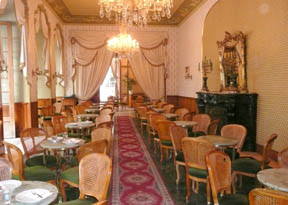
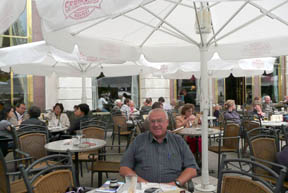 We then
walked
down Vaci street to an authentic goulash restaurant where we had a goulash lunch
with the natives. We returned to Vaci Street to
shop for linens and souvenirs, and then stopped for afternoon
pastry at Gerbeaud Patisseries. We took the subway
and bus back to castle hill and had dinner at a local restaurant.
We then
walked
down Vaci street to an authentic goulash restaurant where we had a goulash lunch
with the natives. We returned to Vaci Street to
shop for linens and souvenirs, and then stopped for afternoon
pastry at Gerbeaud Patisseries. We took the subway
and bus back to castle hill and had dinner at a local restaurant.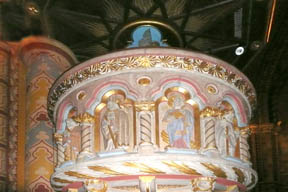
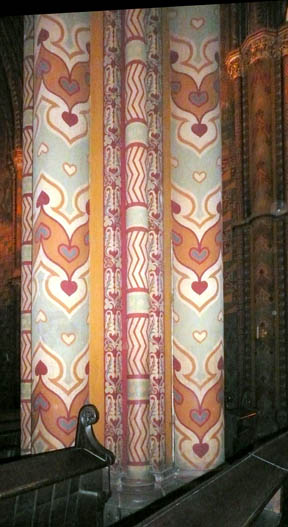
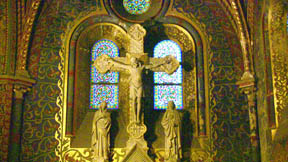
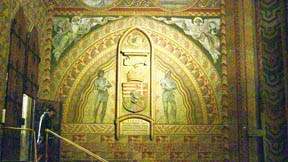
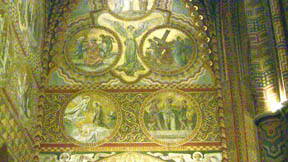
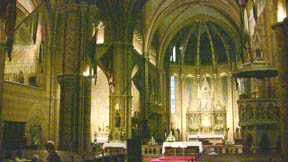
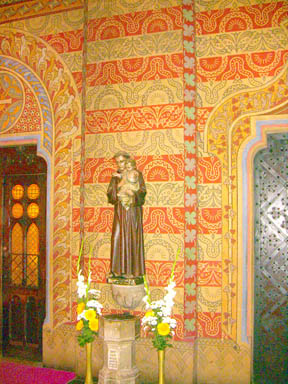 The
style was then
changed to Gothic.
The
style was then
changed to Gothic.
